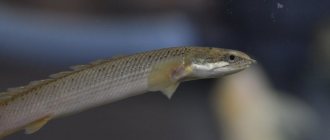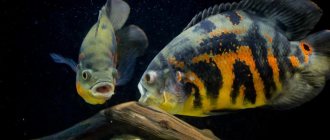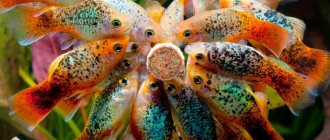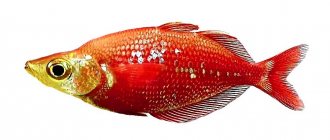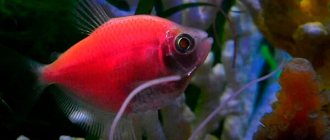Endlicher's polypterus (Polypterus endlicheri) is a fish belonging to the genus Polypteridae. They inhabit Africa, live in the Nile and the Congo River. But the exotic appearance and habits made Polypterus Endlicher quite popular among aquarium fish lovers. Of course, this fish is more like a dinosaur, with its long body and elongated and predatory snout. Which is not far from the truth, because over the centuries of their existence, multi-feathers have changed little.
Description
This is a large fish, up to 75 cm in length. However, it reaches this size in nature, but in an aquarium it rarely exceeds 50 cm. Life expectancy is about 10 years, although there are individuals that live much longer in captivity.
Polypterus has large pectoral fins, a dorsal fin in the form of a jagged crest that turns into a caudal fin. The body is brown, with scattered dark spots.
Area
Initially described as the species Polypterus endlicheri, in modern classification it has acquired the status of a subspecies Polypterus endlicheri endlicheri Heckel 1847, which, together with another subspecies, Polypterus endlicheri congicus Boulenger 1898, forms the modern species.
In nature, Endlicher's polypper lives in large rivers, lakes and ordinary or mangrove swamps, as well as in river basins located in Africa. The maximum length of a fish of this subspecies was recorded, which, with a body weight of 3,347 g, was 63 cm. The ranges of the Endlicher's polyfin and the Nile bishir almost coincide.
The Congolese multiply lives much further south, in the equatorial zone of Africa. The fish is found in the Congo River basin, as well as in other rivers, lakes and bays. Individuals living in Lake Tanganyika tend to stay in shallow water, closer to the shore, in river deltas and bays. The range of the subspecies is almost the same as that of the Katanga polyplum. The Congolese Polyplum is the largest representative of the Polyplum family. The maximum length that could be recorded was 97 cm with a body weight of 4,380 g.
Keeping in an aquarium
It is important to close the aquarium tightly, as they can escape from the aquarium and die. They do this with ease, since in nature they can move from body of water to body of water over land.
Since Endlicher's Polypterus is nocturnal, it does not need bright light in the aquarium, and does not need plants. If you want plants, it is better to use tall species with wide leaves. For example, nymphea or echinodorus.
They will not interfere with his movement and will provide abundant shade. It is better to plant it in a pot, or cover it at the root with driftwood and coconuts.
Driftwood, large stones, large plants: all this is needed to cover the polypterus, so that it can hide. During the day they are inactive and slowly move along the bottom in search of food. Bright light irritates them, and the lack of shelter leads to stress.
Juveniles of Endlicher's polyfin can be kept in an aquarium of 100 liters or more, while adult fish require an aquarium of 800 liters or more.
Its height is not as important as the bottom area. It is best to use sand as soil.
The most comfortable water parameters for keeping: temperature 22-27°C, pH: 6.0-8.0, 5-25°H.
Diseases and treatment of polypterus
Today, the pet trade offers several types of polypterus . Fish of different ages and sizes are available for sale. Specimens of domestic breeding are usually not large in size; as a rule, they are juveniles, often decorated with a corolla of external gills, which reduce as the individual grows older. Such fish, as a rule, do not have undesirable bonuses in the form of a bouquet of diseases, which are often endowed with grown-up polypterus .
Imported specimens are often carriers of the freshwater leech Macrogyrodactylus polypteri, which attaches to the body of the fish. In search of relief, fish try to rub against decorations or other objects.
In any case, it is recommended to quarantine purchased fish. Any container with a volume from 30 to 100 liters is suitable for this purpose. Free from decor and equipped with a filter, heating pad with thermostat and control thermometer.
During the entire quarantine, which usually lasts about two weeks, the water temperature is maintained at 30°C. Fish must be under constant visual control. In order to immediately take appropriate measures if symptoms of any disease appear.
Currently, there are a sufficient number of various veterinary drugs that make it possible to do without their pharmacy analogues.
In the absence of veterinary drugs, you can use pharmaceutical products. In particular, furazolidone (dosage 5-10 mg/l) and methylene blue (both in combination and separately) are good for fungal infections, treatment of wounds and minor injuries; Biseptol together with metronidazole (at the rate of 10 mg/l of each drug) cope well with various types of internal infections. Oletethrin (5 mg/l) or its analogs helps against fin rot, plaque and similar misfortunes.
Some publications mention the good tolerance of water salinity (up to 10 ppm) by Polypterus
Medications containing copper sulfate should be avoided; they clearly inhibit polypterus , often only worsening their condition.
In general, polypterus are strong, hardy fish with a large reserve of immune strength, rarely susceptible to disease. Their tough ganoid scales provide good protection against bacterial and fungal infections and also make them immune to some parasites.
As a rule, even savages, after going through quarantine without any problems, can easily adapt to aquarium conditions in the future.
Ancient and insufficiently studied polypterus , which have now become available to a wide range of aquarists, are not just an interesting addition to the community of an amateur aquarium, but also a kind of relatively unpretentious living embodiment of fish evolution that does not require complex care.
Feeding
Predators eat live food; some individuals in the aquarium eat pellets and frozen food. From live food you can give worms, zoobass, bloodworms, mice, and live fish. Seafood, hearts, and minced meat are eaten frozen.
Polypterus Endlicher has poor eyesight; in nature, they find prey by smell and attack at dusk or in the dark.
Because of this, in the aquarium they eat slowly and search for food for a long time. More nimble neighbors may leave them hungry.
Polypterus diet
Feeding Polypterus is usually not a hassle. Being carnivorous fish, they happily consume almost any live food - bloodworms, tubifex, etc. As they grow older, their diet can include finely chopped lean meat and various seafood (fish, shrimp, squid). It is possible to accustom Polypterus to dry granulated food. It is important to remember that while having a good appetite, polypteruses are prone to overeating. Therefore, in order to avoid obesity, it is necessary to limit their diet. To stimulate spawning, it is recommended to feed the spawners with small live fish.
Compatibility
They get along well in an aquarium with other fish, provided they cannot swallow them. Good neighbors will be: arowana, large synodontis, chitala ornata, large cichlids.
Diseases and prevention
Polypterus senegalese is not prone to certain diseases. All health problems come from improper care.
Common diseases:
- Obesity. Occurs as a result of violation of feeding standards and incorrect menu planning. Treatment: a strict diet, including only bloodworms and other low-fat food. Feeding frequency during treatment: once every three days.
- Monogenean flukes. The fish becomes depressed, often rises to the lid of the aquarium, and loses its appetite. There may be small worms on the head. Treatment: quarantine and baths using formaldehyde or malachite green.
- Ammonia poisoning. The gills acquire a blue-violet hue, the fish do not accept food, lose interest in life, and try to leave the aquarium. Treatment: general cleaning of the pond, complete water change and thorough cleaning of all decorative items.
To avoid almost all health problems you need to:
- Change the water in a timely manner, preventing it from stagnating;
- Install a powerful filter that cleans the living environment;
- Monitor the diet, do not give large amounts of dry food, do not overfeed with live food;
- Be careful when choosing soil - buy it only at a pet store, and not collect it yourself from a pond;
- If mild symptoms of any disease appear, immediately transfer the sick animal to another tank to protect the rest.
Polypterus senegalese is a luxurious fish that certainly deserves the attention of every aquarist. Although she is picky in her maintenance and unfriendly in the neighborhood, nevertheless, she is also exotic and attractive, which is the main advantage of this African beauty
Breeding
Cases of bishirs spawning in the aquarium have been noted, but data on them is scattered. Since in nature fish spawn during the rainy season, a change in the composition of the water and its temperature serves as a catalyst.
Given the size of the fish, spawning requires a very large aquarium with soft, slightly acidic water. They lay their eggs in dense thickets of plants, so dense planting is necessary.
After spawning, the spawners need to be removed, as they can eat the eggs.
On the 3-4th day the larva will hatch from the eggs, and on the 7th day the fry will begin to swim. Starter food: Artemia nauplii and microworm.
The Endlicher multiper has the following distinctive features:
- the pectoral fins reach a line that is level with the base of the first ray of the dorsal fin;
- in adult individuals, the posterior edge of the lateral line scales is jagged and, in addition, these scales are equipped with a groove; The mouth of fish of this species is upper;
- the anal fin of sexually mature males is much wider and more powerful than that of females.
The above characteristic features are common to both the Endlicher multi-feather and the Nile Bishir. But still there are some differences between the species, namely:
- the body of the Nile Bishir is slightly flattened laterally, while in the Endlicher's polypper it is compressed vertically; in Endlicher's multi-feathers the average number of scales located along the lateral line is 50–59, while in bishirs they are much larger – 58–70;
- the longitudinal stripes on the body of the Nile Bishir are very weakly expressed, but in the Endlicher's multi-feather, the pattern in the form of black vertical stripes of irregular shape is clearly visible;
- In addition, the head and fins of the fish are strewn with small black spots.
Subspecies Polypterus endlicheri also have slight differences:
Subspecies of Endlicher's polypterus (Polypterus endlicheri endlicheri Heckel, 1847). Other names: English: Saddled bichir (saddled, or saddled multi-feather); rus: polypterus tiger.
The upper part of the body of the fish is colored yellow, green and brown, which become paler shades closer to the abdomen. The few saddle-shaped vertical stripes are quite wide. The dorsal fin consists of 11–14 small fins that resemble spines.
Subspecies Congolese polypterus (Polypterus endlicheri congicus Boulenger, 1898). Other names: Polypterus congicus Boulenger, 1898; English: Congo bichir.
The upper part of the body is colored gray, and the abdomen is pale yellowish. Numerous stripes arranged vertically are much narrower than those of the Endlicher multi-feather. The dorsal fin consists of 12–15 small spine-like fins.
Distribution A widespread species, found in Cameroon, Nigeria, Burkina Faso, Ghana, Chad, Ivory Coast, Mali, Sudan, Benin and the Central African Republic. Dragonfish live in rivers and swamps and are sometimes found in brackish waters, especially in areas with mangroves.
Maximum length 75cm. However, this is rarely achieved in captivity.
The recommended aquarium size is 210x120x90 cm - 2300 liters for an adult polyfina. Juveniles can be reared in small tanks. The bottom area is more important than the depth of the aquarium. A soft substrate with driftwood and smooth stones is required. Plants are optional. The aquarium must have a tight-fitting lid.
Water Temperature: 22-27 °C
pH: 6.0-8.0
Hardness: 5-25
Diet of P. endlicheri endlicheri is carnivorous in nature and does not usually accept dry food. The most suitable options are live or frozen foods such as shrimp, earthworms, mussels, and fish.
Ksenia Birkel advises: the diet of our multi-feathers
Polypterus are ancient predators. For a minute, they outlived the dinosaurs!
What to feed? Menu of our multifin: - Shrimp (At the moment, I do not give our multifin shrimp in the shell. If the shrimp is large, then I cut it into pieces); — Fish (We buy frozen smelt. If necessary, I also cut it into pieces. They also get the head and entrails); - Mealworms - larvae and pupae of mealworms (I give only white, recently molted larvae and pupae); — Worms (I give them live, but before that I wash them in cold water); — Banana crickets; — Dry food (Tropical Soft Line Monster Fish, TSL Africa Carnivore; Hikari Massivore delite; Hikari sinking Carnivora; Tropical Supervit Tablet B; Tropical Prodefence); — Frozen fish food (only for babies up to 10 cm);
Exception: our Polypterus senegalus loves spirulina
We feed young polyfins (up to 13 cm) with various frozen fish products, such as gammarus, daphnia, brine shrimp, bloodworms, coretra, cyclops, etc. We also give chopped earthworms and finely chopped shrimp and fish fillets.
How often should I feed? Multi-feathers from 13-15 cm - 2-3 times a week; Multifins up to 13 cm - every day.
Fun fact: If you need to go away for a week, don't worry! Multi-feathers (from 20 cm) can easily survive a week (sometimes even more) without food. But remember, this should only be done in extreme cases.
Multi-feathers have an excellent sense of smell. Sometimes, while feeding, you can see them swimming past the food quite quickly. They stop abruptly and begin to “sniff” the ground and look for food. It's funny to watch how they, like bloodhounds, “follow the trail” and if they lose it, they begin to “back away”, trying to find it again.
Most often, it is during feeding that conflicts arise between fish. My advice is to give several pieces at once and in several places. “The most delicious piece is already in the mouth of another multi-feather” and every multi-feather thinks so.
Since fish need to be fed meat products, it is necessary to install an effective filter. Frequent water changes are necessary. If the fish is lethargic and will not eat, this means that the level of nitrogen compounds is too high, then you should change about 30% of the water volume in the aquarium.
Compatibility It cannot be housed with small fish that it will eat, but otherwise Polypterus endlicher is relatively peaceful. Suitable neighbors include arowana, synodontis, Siamese tiger perch, knifefish, and some large cichlids.
Sexual dimorphism The anal fin of the male is thicker than that of the female.
Reproduction
Because this species spawns during the rainy season in nature, changes in temperature and water chemistry can trigger spawning behavior. A large aquarium is required, which should contain soft, slightly acidic water. Areas with dense planting should be provided. During spawning, the male clasps the female's genitals with his anal and caudal fins. He then fertilizes the eggs before scattering them among the vegetation. At this stage, the adult fish should be removed. Starter food for fry is Artemia salina, nauplii or microworms.
Interesting Facts - An incredibly tenacious, nocturnal species with very poor vision, P. endlicheri endlicheri relies on its excellent sense of smell to find food. This species of polyfeather, along with other members of its genus, are among the last surviving relatives of very ancient species. Fossils of earlier specimens have been found in the Triassic period, which occurred during the early development of dinosaurs more than 200 million years ago.
The dragon fish has several interesting adaptations. The swim bladder is divided into 2 parts, of which the right part is much larger. It functions as an auxiliary respiratory organ - the fish can survive without water for some time if it remains wet. Like Ananbantoid species, Polypterus can actually drown if it is denied access to atmospheric air.
It should be noted that most polyfins offered for sale are wild-caught and, as such, may carry infections or parasites. We recommend keeping a close eye on your new fish for the first few weeks after purchase.
Photo by Ksenia Birkel.
Video about multi-feather
